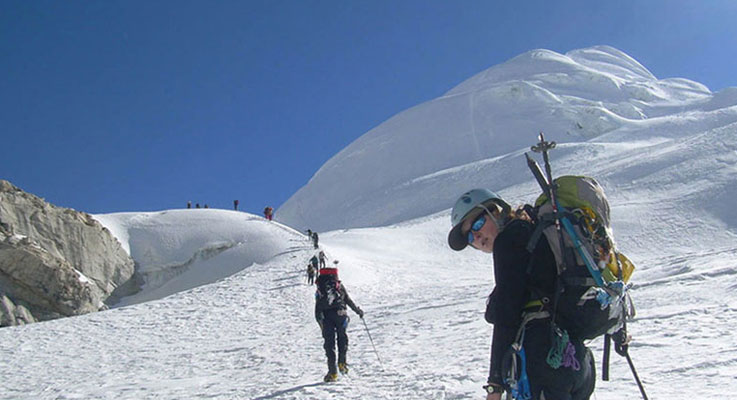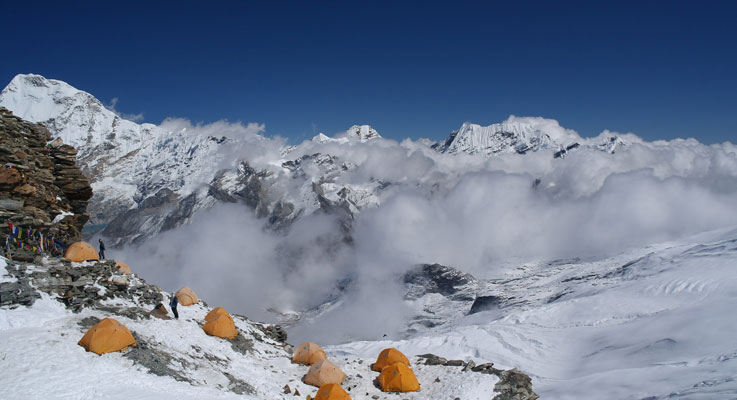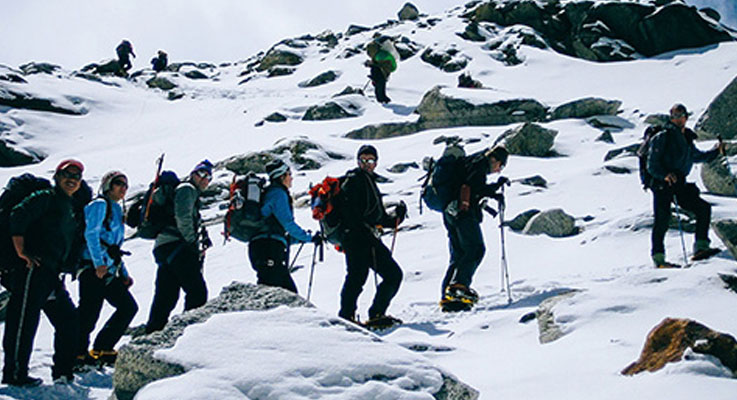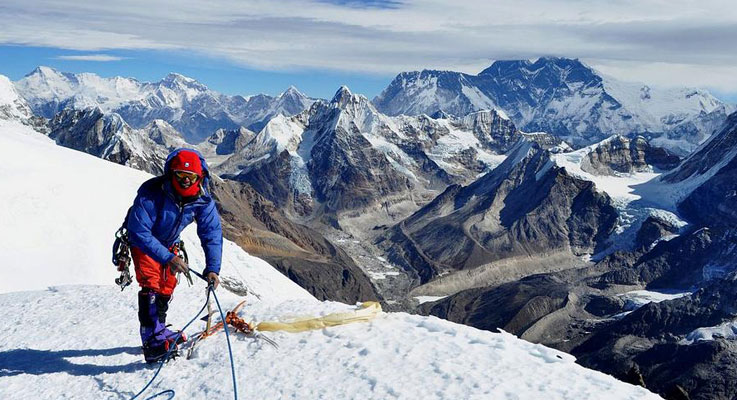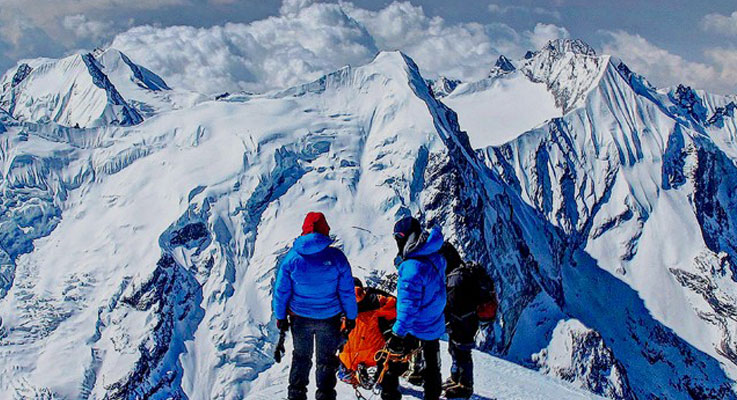-
Day 1
Arrival in Kathmandu (1,300m/4,264ft)
Upon arriving at Tribhuwan International Airport in Kathmandu, you will be received by our airport representatives who will warmly greet you and transfer to the hotel on a private tourist vehicle. We provide 3-star accommodation in the city and we arrange for a trip briefing with dinner in the evening.
-
Day 2
Visit old town of Kathmandu
A professional guide and vehicle are provided for a day of sightseeing in and around Kathmandu city. We visit some of the UNESCO World Heritage Sites in the city along with other interesting cultural monuments that dot the valley. These include Boudhanath Stupa (the largest Buddhist shrines in the world), Pashupatinath (the holiest Hindu temple in the world), Durbar Squares (Palaces and fortresses of medieval Kings), along with other popular cultural attractions. We get to observe the lifestyle of Nepalese people, holy sadhus and monks, fascinating history as well as awe-inspiring architecture.
-
Day 3
Fly to Lukla. Trek to Poyang
Early in the morning, you will be transferred to the airport in Kathmandu for a scenic 30-minute flight to Lukla. The airport guide will brief you and introduce our porters before we begin our trek towards Phakding (2,610m). Follow the path on the south side of the airstrip and descend steeply for half an hour before meeting the main trade route coming up from the south to the Khumbu. Continue descent to Sarke before climbing up to the Chitok La. Some more up and down before arriving at a good campsite at Poyang.
-
Day 4
Trek from Poyang to Pangkongma
After crossing the Poyang Khola turn off the main route onto the old trade route climbing up to the ridge line overlooking the Khare Khola. Reach to Kharte for lunch. After lunch, leaving the main trail start roughly contouring east and descend to subsidiary stream of the Khare Khola. Then steady climb up to the attractive farming and treading village of Pangkongma.
-
Day 5
Trek from Pangkongma to Najing Dingma
Fine views west back to Takshimdu Monastery, Lamjura and north-west to Kwangde. A climb through thick rhododendron forest and bamboo leads to Pangkongma La(3175m) before attractive descent to the small settlement of Shibuje. There are beautiful views from here looking south across the endless foothills rising each side of the Hinku valley and shortly after the descent begins Mera with its twin vertical south face come into sight at the top end of this most impressive valley. After lunch the trail needs are as it drops steeply for one and half two hours down to a small bridge over the Hinku Khola. It is then a tough climb up but potentially good campsite in pasture land at Najing Dingma
-
Day 6
Trek from Najing Dingma to Chalem Kharka
And then deceptively long and steep climb leads to the Surke La(3085m).There is view tower made by Makalu Barun conservation Project, offering excellent view of surrounding mountain and passes. Shortly after we pass the trail that leads east to Tumlingtar and east Nepal and another one leading to a small village called Chosumb. We follow a third away up and cross the slope and have a lunch in Phokte. After one and half-hour or so climb an attractive campsite set amidst for and rhododendron is reached.
-
Day 7
Trek from Chalem Kharka to Khola Kharka
We follow the west side of the ridge before climbing through the last scrub rhododendron. The trail turns north climbing between two bluffs. Passing through more grazing country the route leads us a steep climb and a pass at about 4250m, offering marvelous mountain views east right across to Kanchenjunga and to the north some of the mountains surrounding the Hongu and Hinku villages. More hard work climbing up to around 4450m leads to an ill defined trail down to the banks of the main lake and camp further down near small stream.
-
Day 8
Trek from Khola Kharka to Khote
A steep climb leads out of the valley before the trail encounter along and around towards the main Hinku valley. This is followed be a series of steep descents first west wards down scree, then north west through scrub rhododendron and on into fir. A scrambling descent of around 690m brings us down near the valley floor where we cross the Mojong Khola and on through a boulder strewn forest to a lunch spot at Rondruk Dingma. After the route follows along a fairly rough trail following the bank of the river to Khote.
-
Day 9
Trek from Khote to Tangnag
Today we move camp only to Tangnag about three and half hours along the river and then about an Hour further up to the valley, which offers excellent view of Khusum Khanggaru(6367m), Thamserku(6608m), Khang Taiga (6685m) Lunch and camp will be at the same place.
-
Day 10
Rest Day at Tangnag
-
Day 11
Trek from Tangnag to Khare
The trail leads on upto Dig Kharka and then after lunch steeping upscree before turning east and gradually leveling off into the valley with the Wela La straight ahead and Mera Peak up and to the right. Water can be difficult here
-
Day 12
Trek from Khare to Mera La
We continue and reach the Mera Glacier. Crossing the glacier, we now go up to the Mera La, a pass mounting to 5.415 m. We cross the pass and camp circa 100 meters below - we reached the Mera Peak base-camp. We finally arrived, on our viewpoint amid 6.000, 7.000, and 8.000 meter summits!
-
Day 13
Trek from Mera La to High Camp
If we feel quite strong, we can also climb up straight away. But to be on the safe side we will have a break halfway to the summit to adjust to the altitude. We are going to camp at about 5.750m - on a rocky island in the middle of the glacier . Here, high above, with a little luck we will have a unique view on the most spectacular mountains: Everest, Lhotse, Makalu.
-
Day 14
Trek from High Camp to Mera Summi, then to Khare
We start early in the morning. Here and there, we can look into deep crevasses. Until we reach the altitude of 6.461 m, the summit of the Mera, we will have climbed upward over glaciers and snow slopes for 5 - 6 hours. Sometimes, the track is hardly passable for the last 30 - 40 meters to the summit, because it gets steeper and the slopes are often frozen. -Then the guides fix a rope which you can follow easily and safely until you reach the summit. The exhausting ascent is over now and below us there are valleys, lower mountains and the mighty glaciers. For a short time, we feel like kings in this icy empire. After the exhausting hike this is a fantastic reward - five of the fourteen highest mountains of the world at a glance - shining glacier giants in front of a blue-black sky. Then, we go down again - until we get to the base camp which takes 4-5 Hours.
-
Day 15
Spare Day
-
Day 16
Trek from Mera Peak Base Camp to Tashingh Dingma
About three hours on down the valley lies Gandishang which used to be the site of an old monastery. A good spot for lunch. A little further down we pass a small bridge which was the route used on the way in up the east bank of the river, and continue on down the west bank. Entering rhododendron and fern forests there are some ups and downs before a good camp site is reached at Tashing Dingma. This is long but not too strenuous day trek.
-
Day 17
Trek from Tashing Dingma to Tuli Kharka
The trail turns uphill and soon joins and follows the northern bank of the main stream. There was a spot for an early lunch after about one and half hours of consistent ascent where the stream is crossed. Water becomes more difficult later in the day. The ascent continues after lunch and we gradually climb above the tree line onto more broken and uneven ground. A day of almost constant ascent leads us to Tuli Kharka.
-
Day 18
Trek from Tuli Kharka to Lukla
The climb continues for about one and half hour upto the Zaterwala pass at (4500m). There are a series of chortents and Mani walls marking this pass which offers fine views across to Kwangde, Lumding Himal and Kariolung (6400m).. A good spot for lunch after a long morning. It is about another two hours down through the forest to Lukla.
-
Day 19
Morning flight back to Kathmandu
On your flight back to Kathmandu as you leave Lukla, you can enjoy some last-minute glimpses of the mountains you just recently visited. Upon arrival in Kathmandu, our airport representative will transfer you to your hotel. You can rest and relax throughout the day.
-
Day 20
Leisure day in Kathmandu
Today will be leisure and rest day. You are free to go souvenir shopping, spa and more exploration of the city, or extend your trip to include bungee jumping, rafting, mountain biking, Everest mountain flight and other adventurous activities.
-
Day 21
Departure from Nepal
The trip concludes today. You will be dropped at Kathmandu's Tribhuwan International Airport by our airport representative for your flight departure from Nepal.

